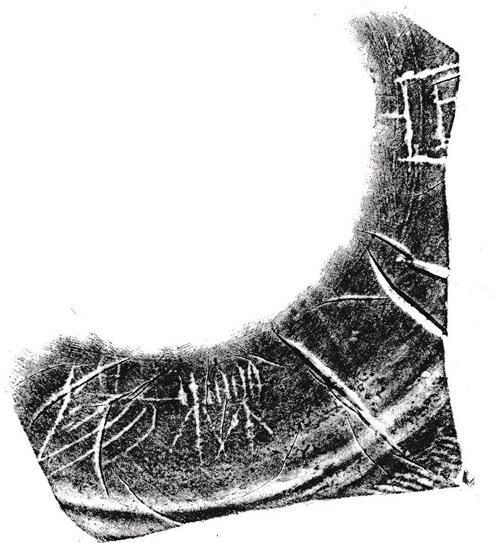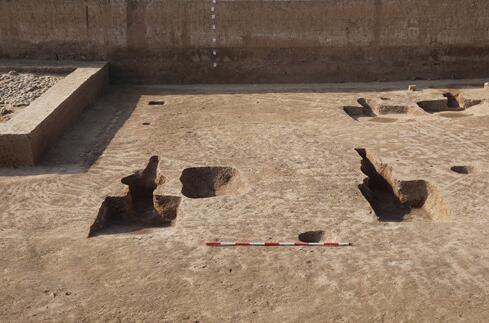New Discoveries of Yueyang Ancient City from Warring State period to Qin-Han Dynasties in Xi’an, Shaan’xi Province
From:Chinese Archaeology NetWriter:Date:2018-04-13
The ruin of Yueyang Ancient City is located in Yanliang District, Xi’an City, Shaan’xi Province. According to historic documents, Yueyang City was the capital in the periods of Duke Xian and Duke Xiao of Qin State during the Warring States period, where the famous ‘Reforms of Shang Yang’ took place. It is also the capital in the periods of Military General Sima Xin (titled of "King of Sai") between Qin and Chu periods, as well as the beginning of Han Dynasty when Liu Bang was the Empire. From 1980 to 1981, Yueyang Archaeological Team belonged to the Institute of Archaeology, Chinese Academy of Social Sciences (IA CASS) found south and west walls of Yueyang City. Inside the city, there were plenty of architectural remains and several roads. In 2013, archaeological excavation was restarted by joint archaeological team consisting of IA CASS and Xi’an Institute of Heritage Protection and Archaeology. From then on, “No.1 Ancient City” was re-explored. During the exploration, “No.2 Ancient City” and “No. 3 Ancient City” were discovered. Several large scale palace architectures remains were figured out from the excavation within No.3 Ancient City. At the same time, trial excavation of White Canal and Zhengguo Canal were conducted, from which runs and locations of both canals were confirmed.
No.3 Building Remain in the No.3 Ancient City
No.1 and No.2 Ancient Cities
In 2013, north wall of the city remains was found during the re-exploration, which was named as “No.1 Ancient City”. According to prospecting digging, it’s sure that the city was 2430m long from south to north. East wall was not found so far. Based on the archaeological materials uncovered, No.1 Ancient City probably belonged to Qin-Han Periods.

Character "yueyang" and "gong" carved on the pottery

Large hearth remains found in the No.4 building in No.3 Ancient City
During exploration of west wall of No.2 Ancient City, relatively large rammed-earth architectural remains were uncovered about 1500m west to the west wall of No.2 Ancient City, which were named as “No.3 Ancient City”. In 2017, north and west walls from two different periods were found in the digging. In the earlier period, north wall with 440m long from east to west and west wall with 180m long from south to north were explored. In the later period, north wall with 105m long from east to west and west wall with 200m long from south to north were explored. So far, south and east walls haven’t been explored yet.
In the south of north wall and east of west wall of No.3 Ancient City, there were four large rammed-earth architectural platforms being found during prospecting digging. They were named as No.1 to No.4 Buildings one by one from south to north. In the south of No.1 Building, a large square courtyard was discovered and each side was about 100m long. Large-scale burned earth and tiles were spread in the south of the courtyard. According to excavations in 2016 and 2017, this area might be handicraft workshop area.

The largest semi-circular tiles found in China so far
In order to figure out its age, form and nature of architectural remains found in No.3 Ancient City, since spring of 2014, small-scale excavations of related architectural remains have been conducted by the archaeological team. No.1 Building was 22.3m wide from south to north. No.2 Building was 11m wide from south to north and about 0.5-0.8m high in residue. Semi- subterranean house was uncovered from rammed-earth platform of No.3 Building. In No.4 Building, there were bathroom and hearth remains. In No.5 Building, bathroom and draining facilities such as pipes and seepage well connecting with floor drain of the bathroom were discovered. They are the earliest, most complete royal bathing facilities with highest rank ever found in archaeological history of China, the baths are thought to have been for the exclusive use of the Qin king and his consort. In the north of No.4 Building, there were four large hearths in two pairs being cleared. They might be 'The Royal Kitchen', which are ancillary facilities related to the royal family’s daily life.
Time and Nature
In the excavation of No.3 Ancient City, there were plenty of semicircular long tiles with fine cord pattern and relatively thick cord-pattern and arched pan-tiles. Architectural materials including pan tiles, plain eave tiles and eave tiles with animal-figure pattern and cloud pattern were unearthed. Giant semi-circular long tiles with a 73cm length and a 63cm diameter were found, too, which is the largest semi-circular tiles found in China so far. Meanwhile, there were also several shards of eave tiles being found which were similar to those found in Jieshi Palace Site, Liaoning Province. From architectural materials unearthed from excavation, No.3 Ancient City should be later than Yongcheng City and earlier than Xianyang City of Qin State. It might last to early period of Western Han Dynasty. According from the remains and assemblages of No.3 Ancient City, including semi-subterranean architectures, hollow brick steps, giant semi-circular tiles, eave tiles, bathrooms, hearths and so on, related architectural remains should be high-rank palace of Qin State. According to documents and artifacts unearthed from excavation, the time of No.3 Ancient City was probably not earlier than the middle Warring States period, which was the time when Duke Xian and Duke Xiao of Qin State built Yueyang City as their capitals according to the documents. Therefore, No.3 Ancient City should be Yueyang City, capital of Qin State in Warring State period. (Translator: Ma Huanhuan Photograph:China Cultural Relics News.)

